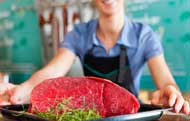
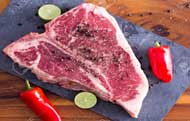
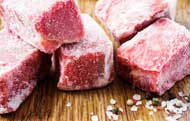
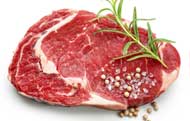
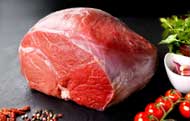
Beef -
Lamb | Pork | Chicken Small Goods | Offal | Game Meats
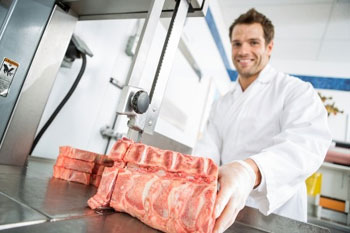
1. Beef Cuts and Produce
2. Cooking Methods
3. Beef Nutritional Value
4. Beef Health Benefits
2. Cooking Methods
3. Beef Nutritional Value
4. Beef Health Benefits
Beef Facts
|
Tips for Cooking and Storage
| Certain cuts of Beef are better suited to particular cooking methods. |
| Selecting Beef Cuts. Meat cooked with the bone in can be especially flavorful because it elicits the natural juices in the bone. Here are some suggestions to consider when planning a meal. |
| ROASTING
Roasting is a dry heat cooking method often used for large, tender beef cuts. Cuts that are delicious when roasted include: |
| PAN-FRYINGPan-frying uses moderate heat to sear but not burn the meat, creating a flavorful browned crust. Cuts that are well suited to pan-frying are: ##Fillet/Tenderloin Steak ##Rib Eye/Scotch Fillet ##Sirloin Steak/Porterhouse/New York Steak ##T-Bone Steak ##Rump Steak ##Round Steak ##Blade Steak ##Oyster Blade Steak ##Silverside Sandwich Steaks ##Minced/Ground for Burgers |
| STIR-FRYINGStir-frying is similar to pan-frying but involves constant movement over high heat and usually includes vegetables or other ingredients along with the meat. The foundation of a great stir-fry is strips of meat cut across the grain into even thickness. They can be cut from: ##Rib Eye/Scotch Fillet ##Fillet/Tenderloin ##Sirloin/Porterhouse/New York ##Rump ##Boneless Blade ##Round ##Oyster Blade ##Topside Steaks |
| BRAISINGBraising usually involves searing the meat on high heat, then cooking it in a flavorful liquid. Less tender cuts are often prepared this way to produce rich flavor and tender texture. Examples of cuts well suited to braising are: ##Chuck ##Topside ##Shins/Shanks – Bone in, osso bucco ##Shins/Shanks – Boneless ##Blade ##Brisket ##Round ##Silverside (uncorned) ##Skirt ##Oxtail ##Beef Spare Ribs ##Cubes |
| GRILLING OR BROILINGGrilling and broiling are very similar in that food is cooked directly with high heat. Broiling is usually done in an oven with overhead heat, while grilling is done by heating the food from below. Grilling is generally done outdoors, although some modern kitchens include a countertop grill with an exhaust system. Examples of cuts that are well suited to grilling or broiling are: ##Fillet/Tenderloin Steak ##Rib Eye/Scotch Fillet ##Sirloin Steak/Porterhouse/New York Steak ##T-Bone Steak ##Rump Steak ##Round Steak ##Blade Steak ##Oyster Blade Steak ##Silverside Sandwich Steaks ##Spare Ribs ##Minced/Ground for Burgers |
Beef Nutritional Value
|
Meats ” Beef ” ( Nutritional value )
Nutritional Value per 100 g Beef, retail cuts, separable fat, cooked |
|||||||||||||||||||||||||||||||||||||||||||||||||||||||||||||||||||||||||||||||||||||||||||||||||||||||||||||||||||||||||||||||||||||||||||||
|
|||||||||||||||||||||||||||||||||||||||||||||||||||||||||||||||||||||||||||||||||||||||||||||||||||||||||||||||||||||||||||||||||||||||||||||
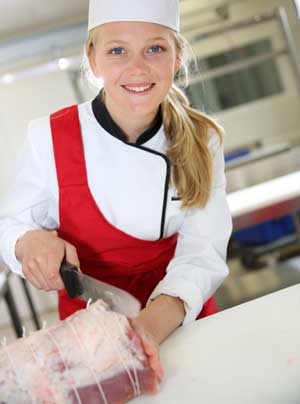
|
Reference Values are based on a 2,000 Calorie Intake, for Adults and Children 4 or More Years of Age. Your daily values may be higher or lower depending on your calorie needs.
|
|
Percentages are roughly approximated using (RDA) Recommended Dietary Allowances for adults. Source: USDA United States Department of Agriculture
|
|
Reference Values for Nutrition – National Institutes of Health USA
|
Beef Nutritional Value
Beef Health Benefits
Beef
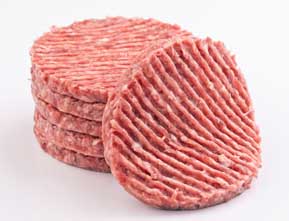
HEALTH
References
|
(1) http://agriculture.vic.gov.au/agriculture/livestock/beef/breeds/breeds-of-beef-cattle
|
|
(2)
|
|
(2)
|
